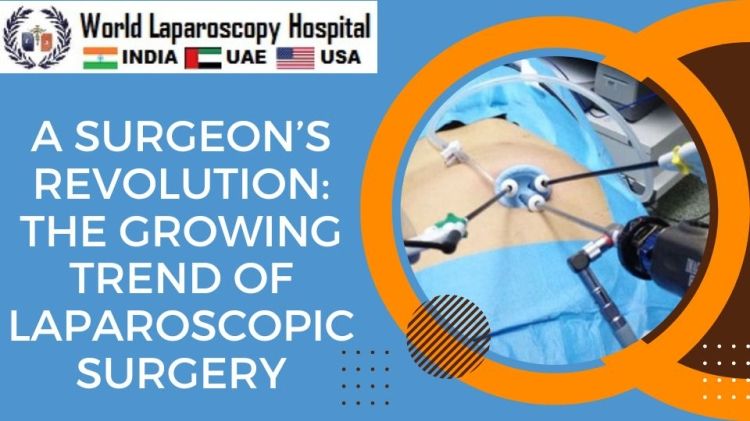Introduction:
In the ever-evolving landscape of medical advancements, one revolutionary technique is reshaping the field of surgery—laparoscopic surgery. This minimally invasive approach has gained significant momentum, challenging traditional methods and offering a paradigm shift in patient care. As surgeons increasingly embrace laparoscopy, this article delves into the intricacies of the procedure, its historical evolution, advantages, challenges, and the profound impact it has on patient outcomes.

Historical Evolution of Laparoscopic Surgery:
The roots of laparoscopic surgery can be traced back to the early 20th century when physicians explored the possibilities of using endoscopes to visualize internal organs. However, it wasn't until the late 20th century that technological advancements allowed for the development of sophisticated laparoscopic instruments. In 1987, the first laparoscopic cholecystectomy (removal of the gallbladder) was successfully performed, marking a pivotal moment in the history of surgery.
Advantages of Laparoscopic Surgery:
Minimally Invasive Nature:
Laparoscopic surgery involves making small incisions through which a camera and specialized instruments are inserted. This minimizes trauma to surrounding tissues, reducing postoperative pain and accelerating recovery.
Reduced Scarring:
Traditional surgeries often leave patients with noticeable scars. Laparoscopic procedures, with their small incisions, result in significantly reduced scarring, contributing to both physical and aesthetic benefits.
Quicker Recovery Times:
The minimally invasive approach of laparoscopic surgery translates to shorter hospital stays and faster recovery times. Patients can often resume their normal activities sooner compared to traditional open surgeries.
Lower Infection Rates:
The smaller incisions not only contribute to faster healing but also reduce the risk of postoperative infections. This is particularly crucial in preventing complications and ensuring a smoother recovery process.
Improved Cosmetic Outcomes:
The cosmetic benefits of laparoscopic surgery are noteworthy. Patients experience less disfigurement, promoting a positive psychological impact on their overall well-being.
Applications of Laparoscopic Surgery:
Gastrointestinal Procedures:
Laparoscopic techniques are widely employed in gastrointestinal surgeries, including cholecystectomy, appendectomy, and colorectal procedures. The precision afforded by laparoscopy in these cases results in reduced trauma to the abdominal area.
Gynecological Surgeries:
In gynecology, laparoscopic surgery has become the preferred method for procedures such as hysterectomy, ovarian cyst removal, and endometriosis treatment. The minimally invasive approach is particularly beneficial in preserving reproductive function and ensuring a faster return to normal activities.
Urological Interventions:
Laparoscopy has made significant inroads in urological surgeries, including nephrectomy, prostatectomy, and bladder procedures. The enhanced visualization and precision enable surgeons to perform intricate maneuvers with greater accuracy.
Orthopedic Applications:
Though traditionally associated with soft tissue surgeries, laparoscopic techniques are finding applications in orthopedic procedures, such as arthroscopy for joint examinations and repairs.
Challenges and Considerations:
Learning Curve:
Mastering laparoscopic techniques requires specialized training and skill development. Surgeons must overcome a learning curve to achieve proficiency, potentially impacting the widespread adoption of the approach.
Equipment Costs:
The initial investment in laparoscopic equipment can be substantial. Hospitals and medical facilities need to allocate resources for specialized instruments and training programs, which may pose challenges in certain healthcare settings.
Limited Tactile Feedback:
Unlike open surgery, laparoscopic procedures limit the surgeon's tactile feedback. This lack of direct touch can be challenging, requiring surgeons to rely heavily on visual and hand-eye coordination skills.
Patient Selection:
While laparoscopic surgery is suitable for a wide range of procedures, not all patients may be ideal candidates. Factors such as obesity, severe adhesions, or complex anatomical issues may necessitate a traditional open approach.
The Future of Laparoscopic Surgery:
Robot-Assisted Laparoscopy:
The integration of robotics in laparoscopic surgery represents a promising frontier. Robotic systems offer enhanced dexterity and precision, overcoming some of the challenges associated with conventional laparoscopy.
Augmented Reality and 3D Visualization:
Advances in augmented reality and 3D visualization technologies are enhancing the surgeon's ability to navigate complex anatomical structures during laparoscopic procedures. This can further improve outcomes and reduce the learning curve for new surgeons.
Expanding Applications:
As technology continues to advance, the scope of laparoscopic surgery is likely to expand into new medical specialties and procedures. Research is ongoing to explore its potential in fields such as neurosurgery and cardiac surgery.
Conclusion:
Laparoscopic surgery has emerged as a transformative force in the realm of surgical interventions. Its numerous advantages, ranging from minimal invasiveness to faster recovery times, have propelled its widespread adoption across various medical specialties. While challenges persist, ongoing technological innovations and the evolution of surgical techniques are poised to further enhance the efficacy and accessibility of laparoscopic surgery. As the medical community continues to embrace this revolutionary approach, patients stand to benefit from improved outcomes and a redefined landscape of surgical care.
